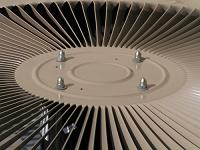
Heat pumps both cool and heat homes by moving heat from one place to another. In the cooling mode, they take it outdoors and in the heating mode, they extract it from the outdoor air and bring it indoors.
HVAC contractors use software called Manual J to perform a load calculation on your home that tells them what the size should be in tonnage. The inputs for the Manual J calculation include:
- Cubic footage you need to condition
- Floor plan layout
- Windows, their orientation to the sun and energy efficiency
- Insulation levels in the attic, walls and floor
- Air infiltration rates
- Heat-producing appliances indoors and lighting types
- Household size and ages of occupants
- Preferred indoor temperatures
- Landscaping factors
One of the benefits of calculating the size using Manual J is that you can see if improving the insulation level in the attic and sealing air leaks would make a difference in the size of the heat pump you need. Being able to choose a smaller system will save you money initially and over the life of the equipment.
Another significant benefit of proper heat pump sizing is that your system won't short cycle; short cycling means it runs in brief periods and turns on and off frequently. This drives up energy bills, leaves humidity behind and increases wear on the parts. The evaporator coil inside the blower won't get cold enough to remove uncomfortable humidity, leaving you feeling warmer and putting your home at risk for mold, dangerous for both you and your home's structure.
The system should run for 15 minutes during a cycle for maximum humidity removal. A system that's too small won't be able to handle the worst weather we experience.
If you'd like to learn more about a heat pump and proper sizing techniques, contact Rodenhiser Plumbing, Heating & Air Conditioning. We've provided outstanding HVAC services for the Route 495/128 area of Massachusetts since 1928.
Image via Shutterstock.com